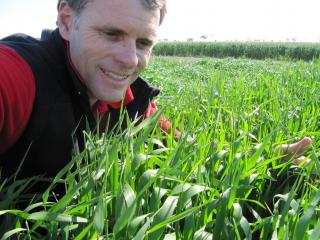Malt barley trials have dispelled the misconception that higher seeding rates to boost yields compromises grain quality for growers in medium to high rainfall areas.
The Department of Agriculture and Food will profile the results of more than two years of field trials at the 2016 GRDC Grains Research Update today (29/2) in Perth.
Department senior research officer Blakely Paynter said although the higher seeding rate had a slight impact on the physical characteristics of the grain, it did not result in more malt barley being downgraded to feed.
Mr Paynter said the target plant densities required to maximise yield and quality varied between malt and food varieties.
“Optimal profitability for Baudin, Commander, Granger and Scope CL was achieved at a target plant density of 120 plants per square metre. Sowing less or more than this density could result in about a $20-25 per hectare penalty,” he said.
“Profit in Bass, Flinders, Hindmarsh and La Trobe was less sensitive to increasing seeding rate. The suggested target plant density for those varieties is 150 plants/m2. It wasn’t until plant densities exceeded 200 plants/m2 that profit started to decrease in those varieties.”
The recommendation for feed barley varieties is 180 plants/m2, as quality does not influence returns.
The higher seeding rate in feed barley also increases crop competitiveness against weeds.
Mr Paynter said growers should use the plant density targets to determine the seeding rate to optimise yield and quality.
“The target seeding rate in kilograms required per hectare will differ between varieties due to seed weight so it is important for growers to determine the weight of their seed so they can calculate the kg/ha to achieve the optimal plant density,” he said.
“As a general rule, Baudin, Commander and Granger would require 60-75kg/ha, Scope CL 65-80kg/ha, Flinders, La Trobe and Hindmarsh 75-90kg/ha, Bass 80-95kg/ha, while feed varieties are recommended to be sown at 80-115kg/ha to achieve the target plant densities.”
Mr Paynter said while the recommendations suited medium to high rainfall environments, further research will be undertaken this season on target plant densities to extend recommendations to low rainfall areas.
“Based on the results of 33 trials throughout the Wheatbelt we are comfortable that those recommendations apply in environments with a yield potential above 1.5 t/ha,” he said.
“In medium to high rainfall environments, we have seen no evidence that the target seeding rate should change if the time of sowing is delayed three to four weeks or if the site potential is 2, 4 or 6 t/ha.”
The research was undertaken as part of the Grains Research and Development Corporation Management of barley and barley cultivars in Western Australia project.
More information on the department’s barley research is available on the department website and more information about how to calculate the kernel weight of barley seed can be found by searching for ‘barley seed rate’.

Media contacts: Jodie Thomson/Megan Broad, media liaison +61 (0)8 9368 3937
